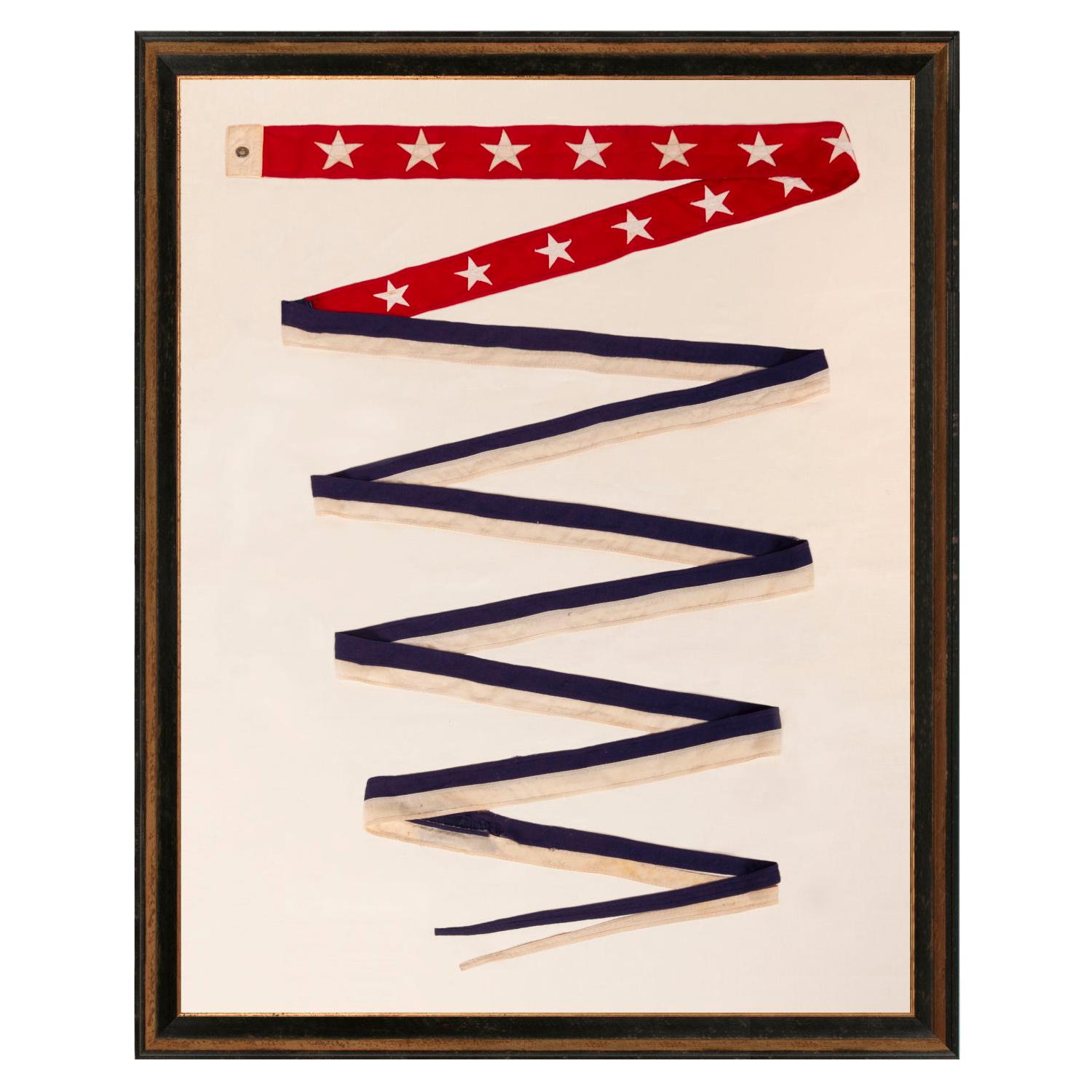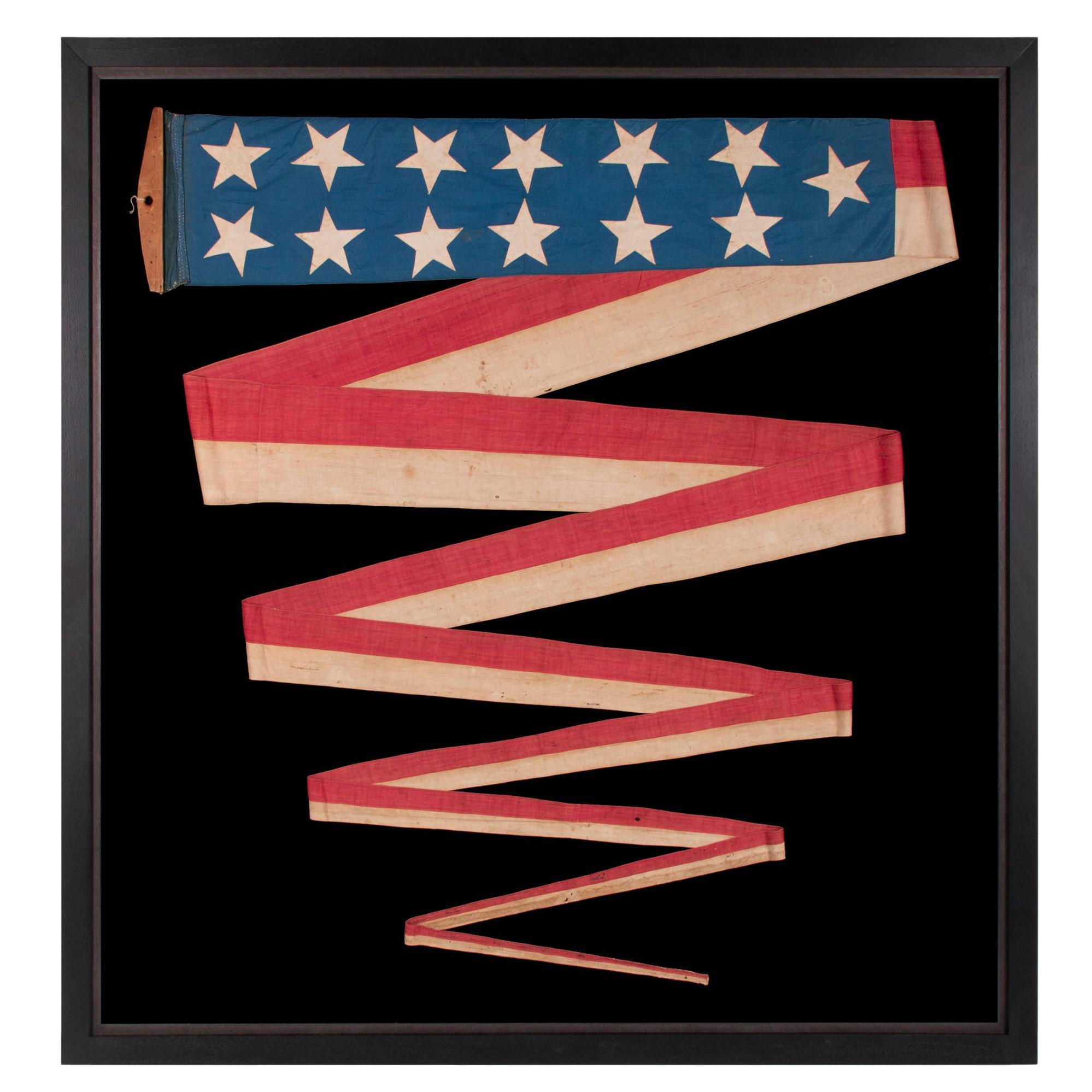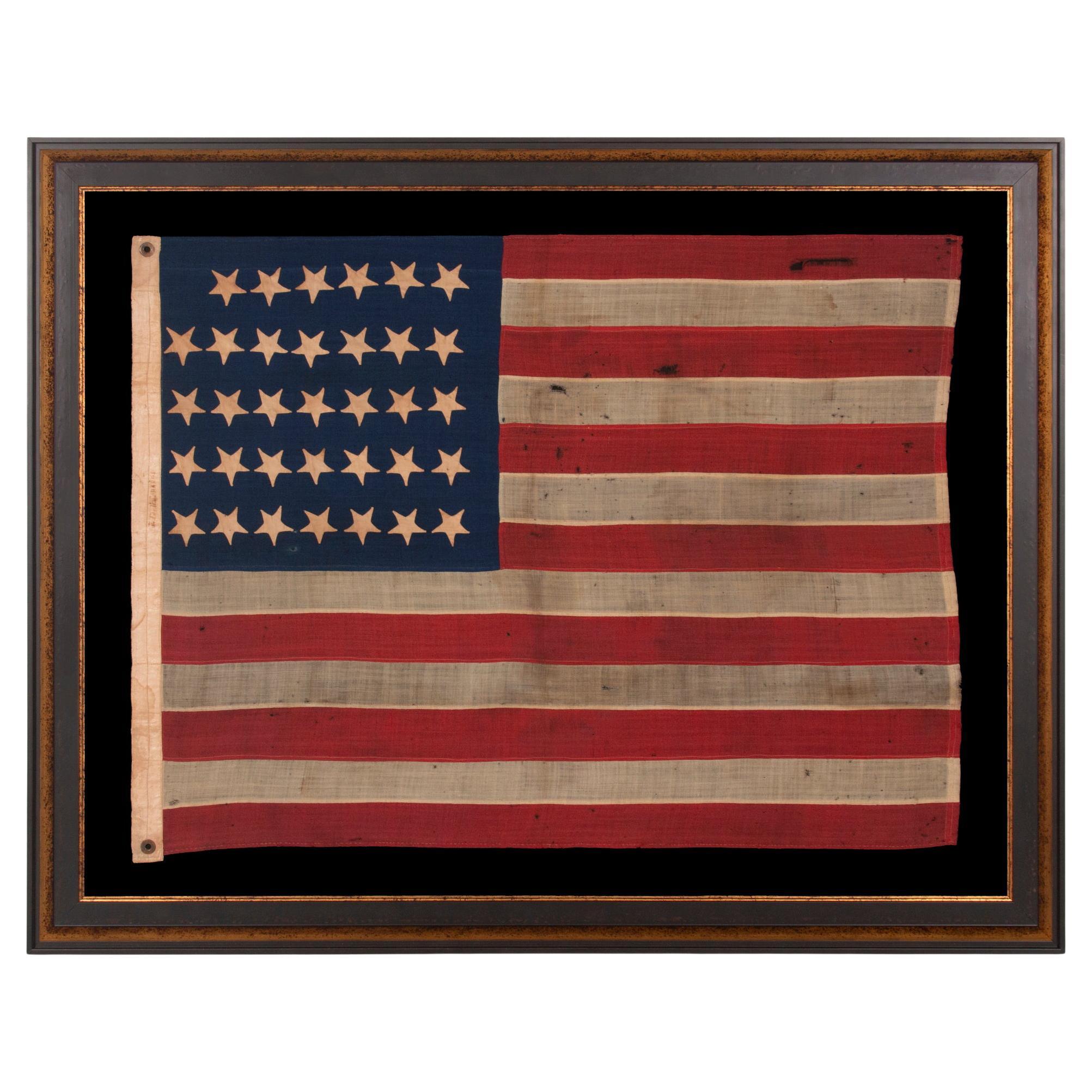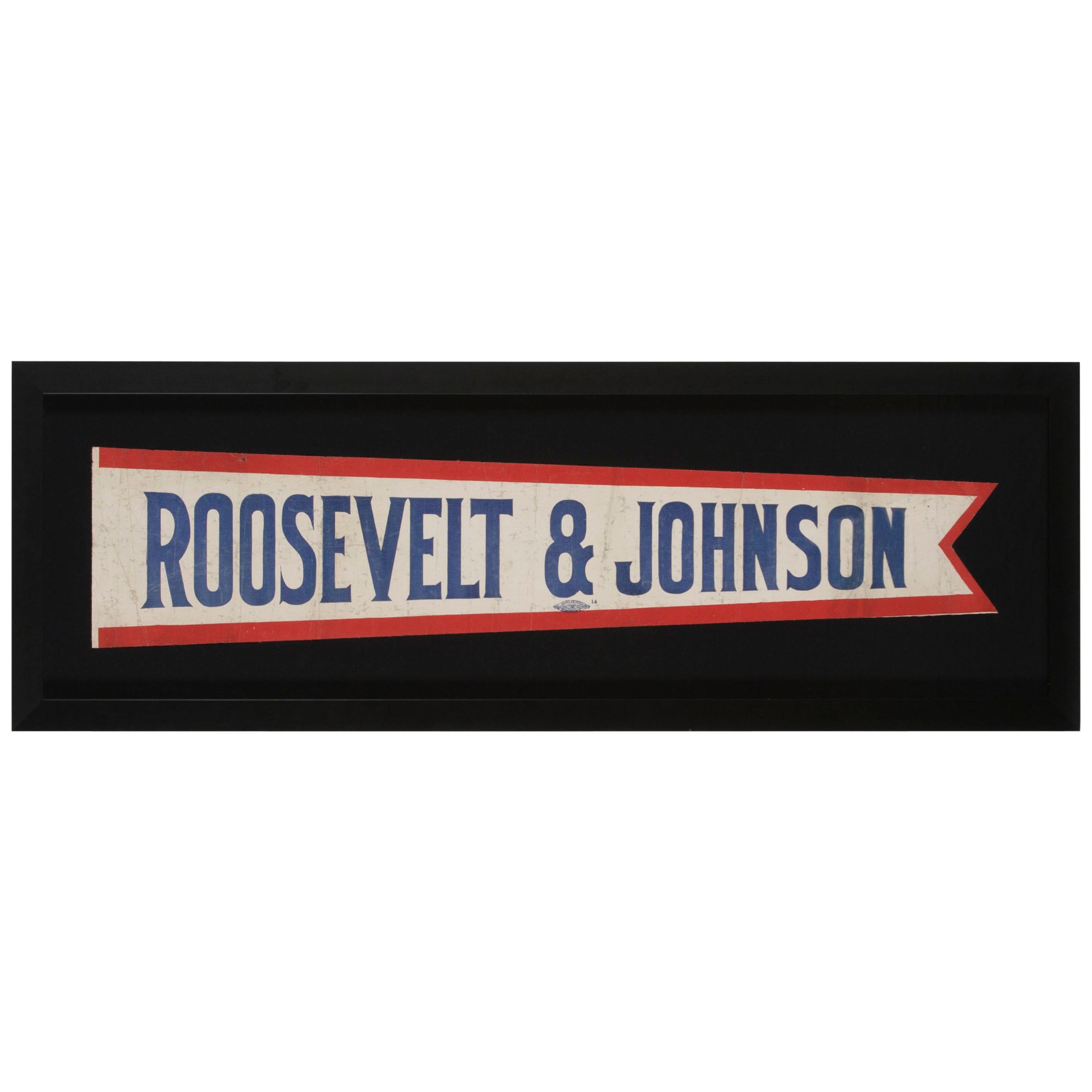Items Similar to Commission Pennant with 13 Stars, like for Private Vessel, Ca 1892-1910
Want more images or videos?
Request additional images or videos from the seller
1 of 5
Commission Pennant with 13 Stars, like for Private Vessel, Ca 1892-1910
About the Item
8-Foot commission pennant with 13 stars, a unique example in my experience, likely produced for display on a private vessel, made circa 1892-1910.
Commission pennants are the distinguishing mark of a commissioned U.S. Navy ship. Flown at the topmast, the typical American format is a long blue field, usually with a single row of white stars, although sometimes with their total divided into two rows, followed by two long stripes, red-over-white. A ship became commissioned when this pennant was hoisted. Flown during both times of peace and war, the only time the pennant is not flown is if a flag officer or civilian official was aboard and replaced it with their own flag.
Sometimes the owners of private ships mimicked the use of Navy signals. Some seafaring men would have served in the Navy and become privy to various practices in that capacity. Others flew them purely for stylistic reasons, either on a regular basis or while the boat was dressed for special occasion. Hudson River steamers regularly flew pennants of this nature, as evidenced by period photography as well as the paintings of artists such as John and James Bard. Mississippi riverboats likely flew them, as did various yachts, and other private vessels.
Probably made between roughly 1892 and 1910, more likely on the earlier end of this date window, this particular commission pennant is a commercially-produced example. It is unusual one, however, in a scale I have not previously owned.
At 4 inches on the hoist [the maximum point] x 8 feet on the fly, the dimensions do not coincide with specified U.S. Navy regulations of the period, or of any period, for that matter. There had been 9-foot style specified in all regulations since 1854, renewed again in 1912. These had a maximum height that remained consistent at 3 inches. But there was never an 8-foot style.
Because there was a great deal of inconsistency in the exact dimension of U.S. Navy small boat ensigns, one might guess that the same might be true of commission pennants. This is difficult to know with certainty, however, because such pennants were so seldom saved, and so few have been documented that are pre-WWI (U.S. involvement 1917-1918). Too few examples survive, private or otherwise, much less with documented history, so one can’t accurately gauge just how well regulations were followed.
In the 1892-1910 era, the Navy seems to have been making most of its own flags, with much of the production of signed and dated examples occurring at the Brooklyn Navy Yard in New York. This flag was not made at that facility, nor any other U.S. Navy site that I am aware of. But we know that the Navy sometimes procured flags from flag-makers directly, when manufacture was neither convenient nor practical. When this occurred, my best, educated guess is that quartermasters did not find it important enough to quibble over having an 4” x 8’ pennant, versus one that was 3” x 9’, at least not if history is any guide. When something was readily available from the likes of Annin, Horstmann, or some alternative source, and there was ample precedence for not following specs precisely, they probably bought what was available and/or practical. As a rule, when it came to flag use, people did what made sense in the 19th century and prior, often settling for what was present and available.
What can be said is that the construction of this particular flag, while very nice, and typical of wool bunting flags of the time, is that it does not display the hallmarks of Navy-produced flags of the same period. For this reason, the intended purpose of its manufacture, regardless of the eventual function, was almost certainly for private use, on a private yacht, or on a commercial/merchant vessel.
Commissioning pennants were once very important in their role as signals and thus needed to be seen from great distance. During the 18th and 19th centuries, some reached as long as a hundred feet. Sometime around 1910, the function of commission pennants leaned away from identification and more toward ceremony and custom. By WWI (U.S. involvement 1917-18) most ranged between just four and six feet in length. Today the largest examples measure two-and-a-half inches by six feet.
Early on, commission pennants had a number of stars equal to that on the national flag. As more and more states joined the Union, however, it became impractical to use the full complement of stars, especially on smaller examples. During the mid-late 19th century, many substituted 13 stars for the full count, to reflect the original colonies. This mirrored the star count used by the Navy on most of the Stars & Stripes flags that it flew on small craft. "U.S. Navy small boat ensigns," as they are called, most often had 13 stars until 1916, when President Woodrow Wilson wrote an Executive Order that ended that practice in favor of the full star count.
Construction: The canton and stripes of the pennant are made of wool bunting that has been pieced-and-sewn by machine. The stars are made of cotton and are double-appliquéd (applied to both sides) with a zigzag, machine stitch. There is a twill cotton binding along the hoist, with two brass grommets. Some pennants of this type terminate at the fly end in a swallowtail format, while others, such as this example, have a blunt end, like this one, which is original to the flag’s construction.
Mounting: The pennant was mounted and framed within our own conservation department, which is led by expert staff. We take great care in the mounting and preservation of flags and have framed thousands of examples.
The background fabric is 100% cotton twill, black in color, that has been washed and treated for colorfastness. Three-dimensional folds were added in the stripes and a shadowbox was created to accommodate the mount. The substantial, black-painted and gilded, with its wide, shaped profile, is Italian. The glazing is U.V. protective acrylic (Plexiglas). Feel free to contact us for more details.
Condition: There is minor mothing throughout, more significant in the stripes than in the union. There are very tiny holes in some of the cotton stars, and modest to moderate areas of soiling throughout the white wool bunting. there is some separation between the blue wool bunting and the binding, with moderate fabric breakdown and loss. Many of my clients prefer early flags to show their age and history of use.
- Dimensions:Height: 32.5 in (82.55 cm)Width: 39 in (99.06 cm)Depth: 3 in (7.62 cm)
- Materials and Techniques:
- Place of Origin:
- Period:
- Date of Manufacture:1892-1910
- Condition:See Item Description.
- Seller Location:York County, PA
- Reference Number:
About the Seller
5.0
Recognized Seller
These prestigious sellers are industry leaders and represent the highest echelon for item quality and design.
Established in 1991
1stDibs seller since 2008
61 sales on 1stDibs
Typical response time: 10 hours
- ShippingRetrieving quote...Ships From: York County, PA
- Return PolicyThis item cannot be returned.
More From This SellerView All
- U.S War Department Commissioning Pennant with 13 StarsLocated in York County, PAEXTREMELY RARE U.S. WAR DEPARTMENT COMMISSIONING PENNANT WITH 13 STARS, A REVERSAL OF THE U.S. NAVY COLOR SCHEME, TWENTY-FOUR FEET ON THE FLY, SP...Category
20th Century American Political and Patriotic Memorabilia
MaterialsWool
- Hand-Sewn 13 Star Cornflower Blue 32 Foot Commission Pennant ca 1845-1865Located in York County, PAENTIRELY HAND-SEWN, 32-FOOT, SHIP’S COMMISSION PENNANT OF THE 1845-1865 ERA, A HOMEMADE, COTTON EXAMPLE, WITH 13 STARS ON A CORNFLOWER BLUE CANTON, IN A BEAUTIFUL STATE OF PRESERVATION Commission pennants are the distinguishing mark of a commissioned U.S. Navy ship. A ship becomes commissioned when the pennant is hoisted. Flown during both times of peace and war, the only time it is not flown is if a flag officer or civilian official is aboard and replaces it with their own flag. Flown at the topmast, this would be the first thing one would see coming over the horizon and identified the vessel as a warship. Sometimes the owners of private ships mimicked the use of Navy signals. Some seafaring men would have served in the Navy and become privy to various practices in that capacity. Others flew them purely for stylistic reasons, either on a regular basis or while the boat was dressed for special occasion. Hudson River steamers regularly flew pennants of this nature, as evidenced by period photography as well as the paintings of artists such as John and James Bard...Category
Antique Mid-19th Century American Political and Patriotic Memorabilia
MaterialsCotton
- 13 Star Antique American Flag with Hand-Sewn Stars in 5-3-5 Pattern, ca 1861-65Located in York County, PAAntique American flag with 13 hand-sewn stars in an extremely rare lineal configuration of 5-3-5, probably made with the intent of use by local militia or private outfitting of a vol...Category
Antique 1860s American Political and Patriotic Memorabilia
MaterialsWool
- Paper Suffrage Pennant with Bold and Whimsical Western Style Lettering, ca 1915Located in York County, PAUnusual paper suffrage pennant, with bold and whimsical, western style lettering, circa 1915 American Suffragette pennant, in a very rare format, with text that reads “Votes for Women,” in a combination of two bold, Western-style fonts. Made of golden yellow paper, with the lettering printed in black, the profile is an unusual one. Linear for approximately 2/5 of its length, the remainder tapers to a point. An example in this style is documented in "The Keynoter: Journal of the American Political Items Conservators," Summer/Fall/Winter 2008 (Women's Suffrage Special Triple Issue), Volume 2008, Number 2-4, p.133. This periodical is the best printed reference that presently exists on Suffrage objects. Golden yellow was the customary color of the suffrage movement in America, a tradition that began with the first actual campaign to give women the right to vote. This took place in 1867 in Kansas, the first state to hold a referendum on the issue when suffragists Susan B. Anthony and Carrie Stanton focused their efforts there and wore sunflowers—the state flower—in a show of support, as well as yellow ribbons. The flower was an appropriate emblem for a rising sun and growth, which led to its use in other states, and the color carried over to many other objects employed in the campaign for years to come. In England, green, white, and purple / violet were introduced in 1908 and became the colors of the movement, which gave way to a nice acronym for “Give Women the Vote.” Various groups used these colors also, in the States, sometimes substituting golden yellow for green. Mounting: The textile was mounted and framed within our own conservation department, which is led by expert staff. We take great care in the mounting and presentation of flags and related textiles and have preserved thousands of examples. This is a pressure mount...Category
Vintage 1910s American Political and Patriotic Memorabilia
MaterialsPaper
- 34 Star Flag with Upside down Hand Sewn Stars, Kansas Statehood, ca 1861-1863Located in York County, PA34 Upside-down, Hand-sewn Stars In A Notched Configuration, On An Antique American Flag Of The Civil War Period, With A Beautiful And Highly Unusual Jacquard Weave Binding, And In A Tiny Scale Among Its Counterparts, Reflects The Addition Of Kansas As The 34th State, 1861-1863 34 star American national flag with a number of interesting and desirable features. Chief among these is the scale of the flag among counterparts of the period. At just three by four feet, its size is absolutely tiny among those with pieced-and-sewn construction. During the 19th century, sewn flags (as opposed to those that were printed on cloth) were typically eight feet long and larger. This is because they were important in their function as signals, meaning that they needed to be seen and recognized from great distance. A flag that was six feet in length was considered small and production of flags smaller than this was extremely limited. Even infantry battle flags, carried on foot, were approximately six by six and-one-half feet, about the size of an average quilt of the same period. It wasn't until the 1890’s that manufacturers began to produce smaller sewn flags in great quantity. The stars of the flag are arranged in justified lineal rows, the first of which contains one fewer star. This results in what I call a “notched” design, leaving one space open for the addition of another star. The blank space leaves little doubt that the maker of the flag assumed that another Western Territory would soon acquire statehood, or that West Virginia might soon break free from Virginia, which occurred in June of 1863. Note how the stars are oriented so that they are upside-down on their vertical axis, with two points up instead of one. No one knows if this positioning bore any particular meaning. Both modern notions of the correct orientation of a star, and the present official design of the American flag, dictate that the stars are supposed to have one point up. Since there was no official design for the flag until 1912, however, it may simply be that the maker of the flag did not consider any particular position to be right-side-up or upside-down. In the mid-19th century, it was not uncommon to see stars pointing any which way, varied throughout whatever arrangement was chosen. Whatever the case may be, the feature present on this particular flag is unusual to the eye and notable in terms of its presentation. Made of cotton, the stars are hand-sewn and double-appliquéd (applied to both sides). The canton and stripes of the flag are made of wool bunting. Because blue wool bunting generally came in a width of 18", the canton was pieced from two lengths of fabric, joined by hand-stitching. The canton is joined to the striped field by hand-stitching. The stripes are pieced and hemmed by treadle stitching. Made of heavy, polished, jacquard weave linen, the binding of the flag is both exceptional from a textile connoisseur’s perspective and highly unusual. This is joined to the flag by treadle stitching. There are two brass grommets, one each at the top and bottom of the hoist, which are likewise especially unusual, in that they are both heavier than normal and intentionally hammered flat. I have seen this on only one other occasion in a Civil War flag...Category
Antique Late 19th Century American Political and Patriotic Memorabilia
MaterialsWool
- Elongated Pennant Made for the 1912 Presidential Campaign of Roosevelt & JohnsonLocated in York County, PAELONGATED PENNANT MADE FOR THE 1912 PRESIDENTIAL CAMPAIGN OF THEODORE ROOSEVELT & HIRAM JOHNSON, WHEN THEY RAN ON THE INDEPENDENT, BULL MOOSE / PROGRESSIVE PARTY TICKET: Elongated,...Category
Vintage 1910s American Political and Patriotic Memorabilia
MaterialsCotton
You May Also Like
- US Air Corps in Australia Vintage Military Pennant, circa WWIILocated in Colorado Springs, COPresented is a souvenir felt pennant celebrating the servicemen and women of the U.S. Air Corps who were based in Australia and fought alongside members of the Royal Australian Air Force during WWII. The navy pennant features a printed red outline of the Australian continent with the U.S. Air Corps “wings” superimposed on it. Below, the text reads, “Souvenir of U.S. Air Corps in Australia.” At the very bottom of the pennant is the U.S. Air Corps symbol. Framed according to archival standards, this pennant symbolizes the collaborative partnership between the United States and Australia during the height of the Second World War in the Pacific Theater. Following the swift Japanese conquest of the Philippines and East Indies in late 1941, the remaining servicemen of the United States Army Air Force in the Pacific eventually relocated to Australia, to join other US and Australian units, including the Fifth Air Force, and regroup. The Fifth Air Force was placed under the command of Major General George Kenney in July of 1942. Their new goal was to seize air superiority over New Guinea and gain back air coverage over the Solomon Sea. General Kenney worked with U.S. Army General MacArthur...Category
Vintage 1940s Australian Historical Memorabilia
MaterialsFelt
- Antique 13-Star Patriotic Sash by Louis E. Stilz & Bros., Early 20th CenturyLocated in Colorado Springs, COPresented is an original patriotic sash from the early 20th century, featuring 13 stars against a bright blue field. This sash features appliqued silver stars on a blue canton, red a...Category
Early 20th Century American Historical Memorabilia
MaterialsCotton
- 38-Star Antique American Flag with Unique Canton, circa 1876-1890Located in Colorado Springs, COThis is a striking 38-star American flag. The flag dates to 1876-1890, when Colorado (represented by the large star in the center of the flag’s canton) joined the Union as the 38th s...Category
Antique Late 19th Century American Political and Patriotic Memorabilia
MaterialsMuslin
- 39-Star Antique American Flag with 'Whimsical' Star Pattern, 1889Located in Colorado Springs, COThis is a 39-star unofficial American flag, handmade and printed on cotton. The flag dates to 1889 and has a unique history, thanks to its rare star-count. The flag’s canton is prin...Category
Antique 1880s American Political and Patriotic Memorabilia
MaterialsCotton
- William & Mary Rare Pewter Trefid Spoon with Portraits, Circa 1690Located in Bishop's Stortford, HertfordshireVery rare William and Mary pewter trefid spoon the handle molded in relief with portraits and dating from around 1690. The spoon has an elongated rounded ...Category
Antique 17th Century English William and Mary Political and Patriotic Me...
MaterialsPewter
- Antique Federal Eagle American 50 Star Flag with Brass Eagle Pole, 19th CenturyLocated in Oklahoma City, OKMonumental 50 star American Flag with antique Federal Eagle brass and wood pole. A patriotic piece suitable for any home. This set includes both ...Category
Antique 19th Century American Federal Political and Patriotic Memorabilia
MaterialsBrass, Bronze
Recently Viewed
View AllMore Ways To Browse
Like New Furniture
Like New Used Furniture
Black Memorabilia
United States Documents
Used Patriotic Memorabilia
Memorabilia Patriotic Political
100 Stars
Mens 13
Antique Black Memorabilia
Antique Wool Scales
Antique Political Memorabilia
Antique Patriotic Memorabilia
Stars Fabric
Warring States Period
Small Framed Folk Art
19th Century American Politics
Machine Stitched
Dress 1910





